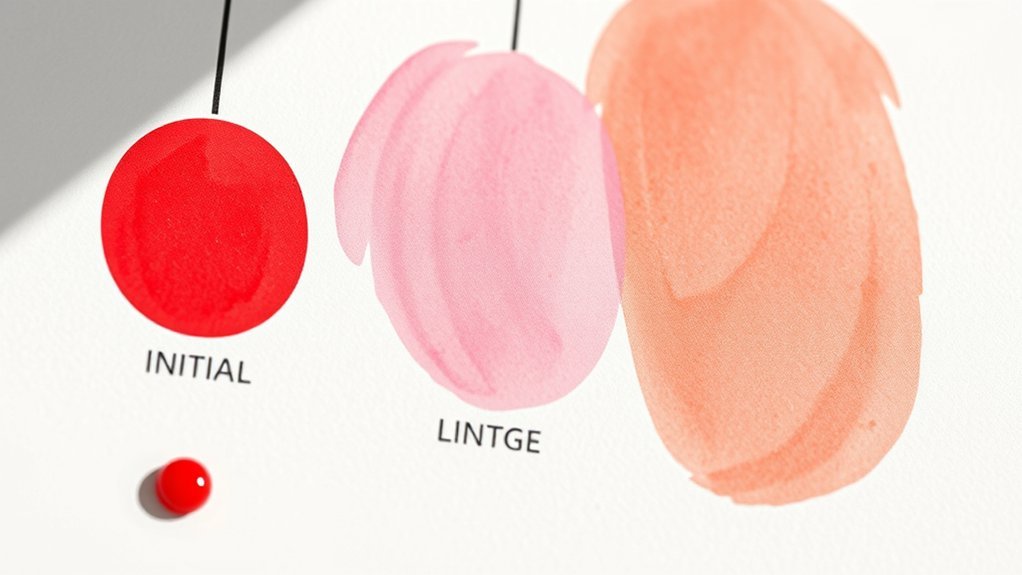Postpartum bleeding can feel like a river that flows through the early days of motherhood, marking the shift to a new chapter. Understanding lochia stages is essential for recognizing what’s normal and what isn’t. You’ll likely have questions about how long these stages last and their characteristics. Knowing this information can greatly enhance your postpartum care, but it’s just the beginning of what you need to know.
What Is Lochia or Postpartum Bleeding?
Lochia, also known as postpartum bleeding, is a natural process that occurs after childbirth. This vaginal discharge consists of blood, mucus, and tissue from the uterine lining.
Initially, you’ll experience lochia rubra, characterized by dark or bright red discharge, which typically lasts for the first three to four days. Following this, the discharge shifts to lochia serosa, a pinkish-brown fluid lasting from four to twelve days.
Initially, expect lochia rubra, a dark or bright red discharge lasting three to four days, transitioning to lochia serosa after.
Finally, you’ll notice lochia alba, a yellowish-white discharge that can persist from twelve days to six weeks. Normal postpartum bleeding can last anywhere from four to eight weeks.
Monitoring the bleeding duration and any changes in color or flow is essential, so consult your healthcare provider if you notice any abnormalities.
Is Postpartum Bleeding Normal?
Postpartum bleeding, or lochia, is a normal part of your recovery process after childbirth, whether you’d a vaginal birth or a cesarean section.
You’ll notice that lochia changes in color and consistency over time, shifting from bright red to pinkish-brown and finally to yellowish-white.
It’s important to monitor your bleeding for any signs of abnormality, such as excessive volume or a foul odor, which may require medical attention.
Understanding Lochia Stages
After giving birth, you may notice a discharge known as lochia, which is a natural part of your body’s healing process.
Lochia occurs in stages: Lochia Rubra, Lochia Serosa, and Lochia Alba.
Lochia Rubra is the heaviest, characterized by dark red discharge that lasts 3-4 days and may include small clots.
Following this, Lochia Serosa presents as pinkish-brown discharge, lasting 4-12 days.
Finally, Lochia Alba appears as yellowish-white discharge that can persist for up to six weeks.
While some fluctuation in bleeding is normal, you should seek medical attention if you soak a pad in under an hour or notice foul-smelling discharge.
Monitoring these stages is essential for your postpartum recovery.
Normal vs. Abnormal Bleeding
Bleeding following childbirth is a common experience for new mothers, typically lasting between four to eight weeks. This postpartum bleeding, known as lochia, progresses through three stages: lochia rubra, lochia serosa, and lochia alba.
Normal lochia may include small blood clots but shouldn’t exceed the size of a golf ball. If you notice excessive bleeding, such as soaking through a pad in less than an hour, or if you experience a sudden increase in bleeding, it’s vital to consult your healthcare provider.
Additionally, lochia should have a menstrual-like odor; a foul or fishy smell indicates potential infection, marking it as abnormal bleeding. Monitoring these signs helps guarantee your recovery from childbirth is smooth and healthy.
Monitoring Recovery Progress
As your body begins to heal from childbirth, monitoring the changes in lochia is essential for ensuring a smooth recovery. Postpartum bleeding is normal, but it’s important to recognize the stages and be aware of warning signs that may indicate complications. Lochia can vary in color and flow, typically evolving from lochia rubra to lochia serosa and finally to lochia alba.
| Stage | Duration |
|---|---|
| Lochia Rubra | 3-4 days (dark red) |
| Lochia Serosa | 4-12 days (pinkish-brown) |
| Lochia Alba | 12 days to 6 weeks (yellowish-white) |
| Heavy Bleeding | Soaking two pads in < 1 hour |
| Warning Signs | Foul discharge, large clots, fever, severe pain |
Consult your healthcare provider if you notice abnormal discharge or persistent heavy bleeding.
How Long Does Postpartum Bleeding (Lochia) Last?
Postpartum bleeding, or lochia, usually lasts between four to eight weeks following delivery.
The duration and intensity can vary based on individual factors, and it’s important to recognize the different stages, from the initial lochia rubra to lochia alba.
If you experience heavy bleeding or notice any abnormal discharge, seeking medical advice is vital.
Duration of Lochia Stages
Understanding the duration of lochia stages is essential for new mothers managing the postpartum period. Lochia typically lasts four to six weeks after childbirth, although individual experiences may vary.
The first stage, Lochia Rubra, lasts about three to four days, featuring dark red discharge with possible small clots. Following this, Lochia Serosa occurs around day four to twelve, presenting as a pinkish-brown discharge that can last up to a week.
Finally, Lochia Alba appears, characterized by yellowish-white discharge with little to no blood, lasting from twelve days up to six weeks.
Being aware of these stages and their duration can help you monitor your postpartum bleeding and guarantee you’re recovering as expected.
Factors Influencing Bleeding Length
The duration of lochia can vary greatly among new mothers, influenced by several factors that affect individual recovery.
Typically, postpartum bleeding lasts from four to eight weeks, but factors like delivery type can greatly impact this timeline. If you’d a vaginal delivery, you might experience lochia for a different duration compared to a cesarean birth.
Additionally, breastfeeding can also influence bleeding length, often leading to reduced postpartum discharge.
Your overall uterine health and any complications during delivery play vital roles in determining lochia stages.
It’s important to monitor your recovery and discuss any concerns with your healthcare provider to guarantee your postpartum bleeding remains within a normal range and to understand the changes in discharge you experience.
When to Seek Help
Knowing when to seek medical help during your recovery is essential as you navigate the stages of lochia.
Postpartum bleeding, or lochia, typically lasts four to eight weeks, starting with lochia rubra, characterized by heavy, bright red discharge. If this bright red discharge persists beyond a week, it’s important to contact your healthcare provider.
Additionally, if you experience heavy bleeding that soaks a pad in less than an hour, seek immediate assistance. Excessive blood loss can pose serious risks, including the potential for infection.
As you progress through the postpartum period, monitoring the changes in discharge is critical for your health, ensuring any abnormalities are addressed promptly.
Always prioritize your well-being and don’t hesitate to reach out for help.
What Are the Stages of Lochia?

As your body begins to recover after childbirth, you’ll experience the stages of lochia, which consist of Lochia Rubra, Lochia Serosa, and Lochia Alba.
Lochia Rubra occurs during the first 3-4 days postpartum, characterized by dark or bright red discharge, similar to a heavy menstrual period, and may contain small clots.
Following this, Lochia Serosa appears from days 4 to 12, presenting as a pinkish-brown discharge that’s thinner and has less blood than Lochia Rubra.
Finally, Lochia Alba emerges around day 12 and can last up to six weeks, featuring a yellowish-white discharge with little to no blood or clots.
These stages reflect the healing process of your uterus, with decreasing volume and changing color as recovery progresses.
When Should You Seek Help?
How can you tell when it’s time to seek medical help during the lochia stages? If you experience heavy bleeding that soaks through a pad in less than an hour or lasts for several hours, don’t hesitate to seek medical attention, as this could indicate postpartum hemorrhage.
Contact your healthcare provider if you pass large blood clots, particularly those larger than a golf ball, since this may signal complications. A sudden return of excessive bleeding after it had lightened is also concerning.
Additionally, foul-smelling discharge may indicate an infection, while severe abdominal pain or cramps that don’t subside with normal care require immediate evaluation. Recognizing these signs is vital for your health and recovery.
How to Manage Lochia at Home?
Managing lochia at home is essential for your recovery during the postpartum period. Start by using heavy-duty sanitary pads for the first few days, shifting to regular pads as your lochia flow decreases.
Change pads frequently, ideally every 2-3 hours, to maintain hygiene and minimize the risk of odor or infection. Avoid tampons and vaginal inserts for at least six weeks.
Monitor the color and flow of lochia; any sudden changes, foul odor, or excessive bleeding may require medical attention.
Practicing good hygiene is vital—wash your hands before changing pads and shower regularly.
Effective home management of lochia will support your overall postpartum care and enhance your healing process. Additionally, understanding the importance of community involvement in maternal health can provide valuable resources and support during your recovery journey.
Frequently Asked Questions
How Long Does Each Stage of Lochia Last?
Lochia rubra lasts about 3 to 4 days, followed by lochia serosa for 4 to 12 days, and lochia alba can continue from 12 days to six weeks, depending on your individual recovery.
How to Know Lochia Has Ended?
You’ll know lochia has ended when the discharge turns yellowish-white, becomes minimal, and you haven’t seen bright red blood for several days. Light spotting may occur, indicating your body is finishing the shedding process.
How to Know if Lochia Is Infected?
If your lochia smells foul, turns green, or floods your pad with excessive discharge, it’s a red flag. Also, watch for fever, chills, or large clots—these require immediate medical attention. Don’t ignore your body’s warning signs!
When Does Lochia Stop Smelling?
Lochia typically stops smelling by the time you reach Lochia Alba, around four to six weeks postpartum. If you notice a persistent foul odor, it’s essential you consult your healthcare provider for evaluation.
Conclusion
In conclusion, understanding the stages of lochia is essential for your postpartum recovery. By recognizing what’s normal and knowing when to seek help, you can navigate this period with confidence. Remember, postpartum bleeding is a natural process, but if anything seems off, don’t hesitate to reach out to your healthcare provider. You’re not alone in this journey; support is just a call away, ensuring you’re not left out in the cold during your recovery.
